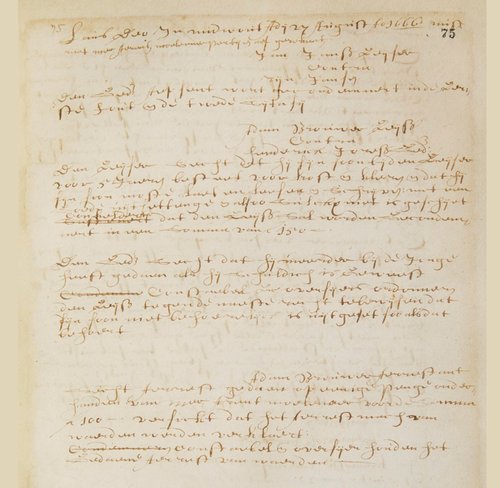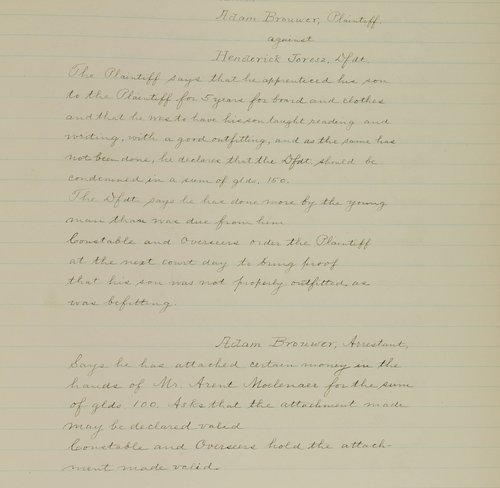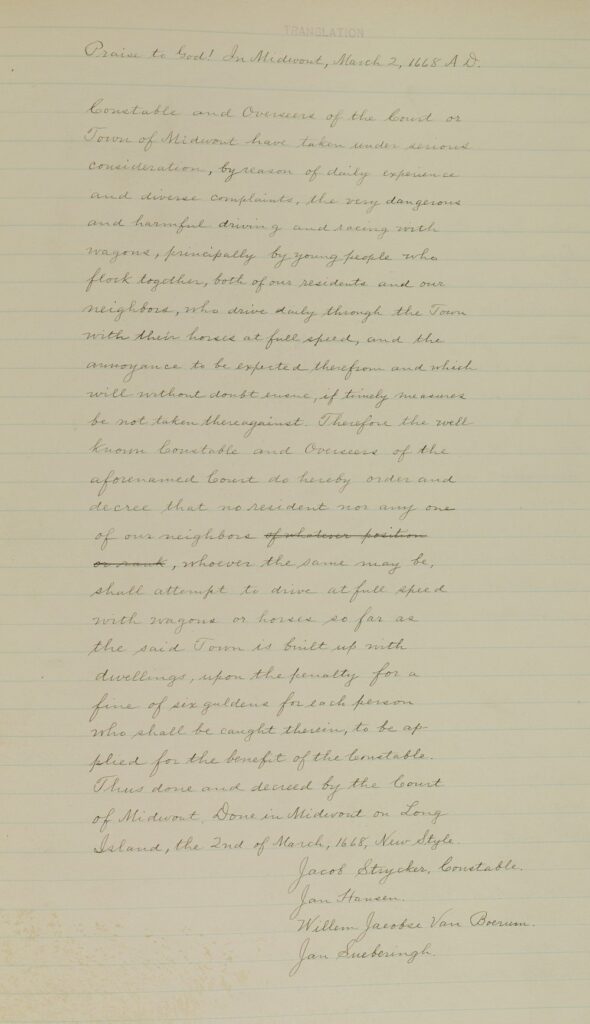This was originally published on the NYC Municipal Archives Blog for the NYC Department of Records & Information Services.
https://www.archives.nyc/blog/2022/9/15/9ytwek2nfygzatyz7mtmh5osdki4r0
When thinking of reckless driving, one might picture teenage motorists drag racing down main streets in revved up automobiles—something like a scene from George Lucas’ 1973 movie American Graffiti, orJames Dean’s 1955 Rebel Without A Cause. You’d be right to think of brash American youths cruising in cars but that’s only the 20th century version. The records in the Municipal Archives Old Town collection show this is not a new phenomenon in the least. This tradition, in fact, goes back to the earliest days of European settlement during the seventeenth century in what is now New York City.
With a grant from the National Historical Publications and Records Commission (NHPRC), the Municipal Archives has been processing the Old Town collection. It is comprised of records created in the villages and towns that were eventually consolidated into the Greater City of New York in 1898. They date to the 1600s and consist of deeds, minutes from town boards and meetings, court records, tax records, license books, enumerations of enslaved people, school-district records, city charters, and information on the building of sewers, streets and other infrastructure.


Among the Kings County town records is a ledger from Midwout—now Flatbush, Brooklyn. This is the entry for March 2, 1668: “Constable or Overseers of the Court or Town of Midwout have taken under serious consideration, by reason of daily experience and diverse complaints, the very dangerous and harmful driving and racing with wagons, principally by young people who flock together, both of our residents and our neighbors, who drive daily through the town with their horses at full speed.”
Danger and speed appealed to youth long before the rise of the American teenager in the 1950’s. It may be easy to find humor in horses and wagons full of “young people flock together” careening down the dirt roads that made up Midwout of 1668, a settlement that consisted of a small population of farmers and merchants and perhaps a tavern and a few shops, terrorized by the adolescent amusement of the day. But the leaders of Midwout took it seriously. According to the March 1668 ledger entry, the Constable and Overseers “ … do hereby order and decree that no resident or any one of our neighbors . . . shall attempt to drive at full speed with wagons or horses … upon the penalty for a fine of six guilders….”
The records of the Old Town collection tell us that the lives and experiences of New Yorkers four centuries ago may not be so different than our own. To find young people looking for excitement and the older townspeople disturbed by the ruckus is timeless and perhaps universal.

The activities of youth in this time period received attention for their welfare as well as their misbehavior. This can be seen in the August1666 case Adam Brouwer, Plaintiff, versus Hendrick Joresz, Defendant, as recorded in the Midwout/Flatbush ledger. The entry states that Mr. Brouwer’s son was apprenticed to Mr. Joresz for five years “for board and clothes and that he was to have his son taught reading and writing, with a good outfitting.” It appears that the standard of care for the boy was lacking and the father claimed “the same has not been done.”
There is a general conception that apprenticeship in this period could be a harsh time, usually beginning when he was ten to fifteen years-old under a Journeyman or Master Craftsman. European literature certainly has numerous stories of runaway apprentices and cruel masters. However, this record from the Old Town collection shows us is there was oversight and consequences for poor treatment of young people in the community. They may have been rambunctious and in need of discipline for their reckless driving, but their well-being was important to their parents and the courts. Mr. Joresz said he had “done more by the young man than was due from him” but the court continued the case to resolve the matter. The “Constable and Overseers order[ed] the Plaintiff at the next court day to bring proof that his son was not properly outfitted, as was befitting.”
The resolution of the matter appears to be that a sum of 100 guilders was provided to Mr. Brouwer, which we can assume was put toward clothing and care for his son.
The view of our colonial past is often so filled with battles, construction of buildings or shipping of exotic goods that it’s hard to see the simple experiences of growing up in that period. A father seeing to the welfare of his son, separated by an apprenticeship illustrates how parents cared for their children just the same as they do today. Perhaps more humorously, we can also see how adolescent misbehavior is a staple of humanity that runs through every age. The history of drag racing may not be one of safety but it connects our era to one long ago. More of these slices of life can be found in the pages of the Old Town collection.
Both entries cited in this article can be found in Town of Flatbush Town Records, Liber D: Court Minutes, Vol. 1, 1664-1670, translated 1915. The original Dutch ledger is also extant and housed in the Municipal Archives.